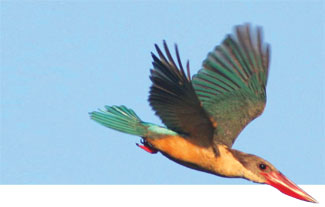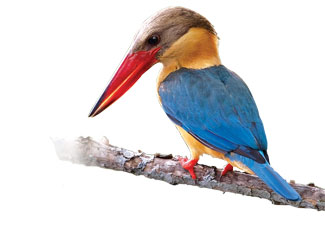Nesting behaviour of stork-billed Kingfisher
by K.G.H. Munidasa
On a rainy day in the latter parts of last November, a pair of
stork-billed kingfishers visited my home garden, and were making a big
commotion at a stumpy, dead “mara” tree (Albizzia species) at the edge
of the garden.
The dead tree was hardly twenty-five yards from my verandah, and I
watched their behaviour with binoculars.
I noticed that while one of the pair clung wood-peckerwise to the
underside of the slanting trunk of the tree, as if looking for a
suitable place for a nest-hole, the other perched on a nearby branch
uttering a peer-peer-per call, repeatedly.
 However,
when I looked for the pair twenty minutes later after my breakfast, they
were missing. Yet, as I listened attentively, I could hear their loud
chatter in the direction of a stream, the well-shaded precincts of
which, to my knowledge, was the retreat of at least two pairs of this
kingfisher. However,
when I looked for the pair twenty minutes later after my breakfast, they
were missing. Yet, as I listened attentively, I could hear their loud
chatter in the direction of a stream, the well-shaded precincts of
which, to my knowledge, was the retreat of at least two pairs of this
kingfisher.
Although, I used to visit this place as often as I could, I had never
observed any signs of nesting or come across juvenile kingfishers about.
Many of my readers may have not seen this attractive kingfisher,
nicknamed “Laughing Jack-Ass”, owing to its loud, laughing call
resembling that of the native Australian kingfisher Dacelo gigas,
popularly known by that name, though our bird differs much in size and
the colouration.

Few other birds excel the stork-billed kingfisher in beauty. The
colours it wears include light-brown on head, face and neck, orange buff
on the under plumage, bluish-green on the back and wings, and the rump
turquoise-blue. The blood-red beak and the coral-red legs add further to
its charm.
According to Phillips’ Annotated Checklist (1978 Revised Edition)
vide page 55, the stork-billed kingfisher Pelargopsis capensis capensis
Sin. “Maha Pilihuduwa” or “Watura-Anduwa” is a breeding resident in both
the Low-Country Wet and Dry Zones of Sri Lanka.
Given to be plentiful, in small numbers, in the vicinity of large
streams, rivers, reservoirs and lagoons throughout the lowlands, it
occasionally follows streams up into the foot-hills to altitudes of
about 2000 feet. Found to be commoner on the northern half of the
island, it also occurs in most parts of India.
Unquestionably, the largest of the six species of resident
kingfishers in Sri Lanka, the stork-billed kingfisher normally moves
about in pairs, but hunts singly, keeping touch with the mate by
uttering a loud chattering laugh ke-ke-ke-ke-ke and also at times, a
soliloquy peer, peer, per., when resting contentedly on some shady
branch, Fish, crabs, frogs and reptiles form its normal diet, and
occasionally it takes young birds or eggs from nests.
The breeding season of this large kingfisher is in the early part of
the year, January and February being the two favourite months. To quote
Henry, there seem to be a very few records of the breeding of this
species in the island.
In opposition to the opinion expressed by Vincent Legge (1881),
W.E.Wait (1931) and others that the stork-billed kingfisher nested in
holes dug on shady banks of rivers or lonely tank bunds, Henry cites an
instance where he had observed a pair digging a nest-hole in the hole of
a big Kumbuk tree in jungle on the banks the Kala Oya, vide Page 141 “A
guide to the Birds of Ceylon” - First Edition (1955).
He records as follows: “The tree had a large cavity, full of rotten
wood in its trunk, about three or four feet from the ground, and the
kingfishers were excavating this.
They took turns to fly at the hole from perches about four yards
away, grip a bit of the rotten stuff, and drop it on the way back to the
perch; now and then one would cling to the tree for a few seconds while
it probed into the hole as far as it could reach, no doubt, loosening
more rubbish.
They worked assiduously for the half hour that I watched them, each
bird making one journey a minute. Unfortunately I was unable to follow
up the observations.
”In my career of watching birds, on my own at the beginning and later
as a contributing member of the Ceylon Bird Club, I may have by now
spent sixty-plus years of my life dedicated to it.
Apart from observations of general interest, I have over the years
recorded in the monthly notes of the Bird Club much interesting
first-hand information pertaining to the life and behaviour of many
so-called rarer bird species, resident as well as migrant.
I would consider that it was by some coincidence of sort that in
January 1968, mere thirteen years after Henry published in print his
unique observations on the nesting arrangements of the Stork-billed
Kingfisher, I came upon an identical sight in a wooded area of the Gal
Oya Valley.
That morning I was on my way to a peripheral village on the borders
of the Gal Oya Sugar Plantations to see for myself a nesting place of
the Grey Hornbill reported to me as have been found there, the previous
week. turning-off from the main road, I had walked about quarter-mile
along the margin of an irrigation channel when I came to a fairly wide
expanse of the same channel, studded with dead trees, large and small.
I suddenly saw a pair of large kingfishers, flying up in turns to the
hole of a large tree, and pecking at the dead bark about fifty feet
above the water. Anxious to find out what the pair was actually doing, I
watched them closely with binoculars. The following was the text of my
report to the CBC that month:
“STORK-BILLED KINGFISHER. On the 29th a pair was excavating a hole in
a large dead tree, standing in deep water of a tank.
The site was about 50 feet from the water on the perpendicular trunk.
Resting on a snag below, they flew straight up to the place, turn by
turn, and bit off chunk of the dead wood, while clinging on to the bark
like woodpeckers. They worked less than half a minute at a time, and the
progress was very slow, but they continued.”
Following the above report, I had many a time observed pairs of this
kingfisher making mating calls, both in the Dry Zone and the Wet Zone,
but I found hardly any signs of nesting. Subsequently, in May 1991 I
spotted a pair calling in unison, one of them while flying in circles in
the air and the other perched on the topmost branch of a large dead tree
below.
I was positive they were preparing to breed. But, as in the aforesaid
instance I was unable to follow up observations to the end.
Meanwhile, leafing through the past monthly-notes of the CBC in an
effort to glean material for the present feature, I came across by
chance a note left by a foreigner who had spent several months in the
Gal Oya Valley, years ago, studying the birdlife.
He had recorded having seen a pair of stork-billed kingfishers in
occupation of a cavity of a dead tree in Malayadi Tank (close to the
Hingurana sugar factory), which “looked-like an old nest-hole of the
woodpeckers”. |

